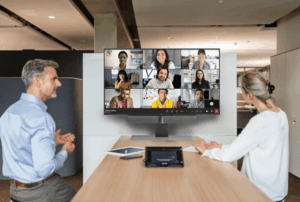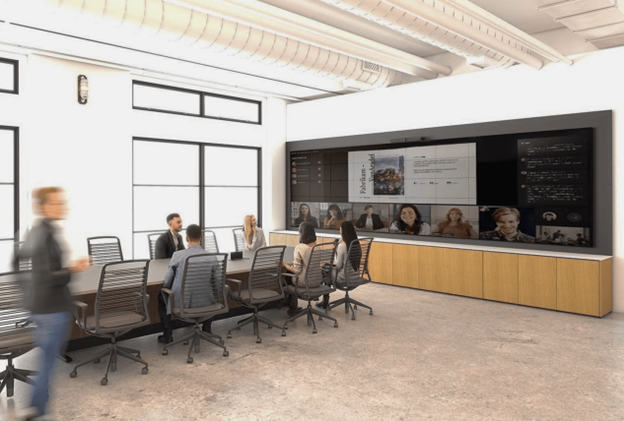Hybrid work has reshaped not just how we work, but where and why we gather. Across every industry, organizations are reimagining offices as places of purpose, hubs for collaboration, creativity, and connection. Yet, as the demand for more technology grows, so does a quiet challenge: how do we integrate advanced systems without losing the human touch that makes a workspace feel inviting?
At BCS Consultants, we see this question at the center of every modern workplace transformation. It’s no longer enough to simply add screens and cameras; the real goal is designing spaces where technology supports people seamlessly, without overwhelming them.
Where Design and Technology Intersect
A decade ago, video conferencing was a luxury. Today, it’s an expectation. Every room, no matter its size or function, is now a potential collaboration hub.
But as connectivity expands, offices risk becoming “over-engineered.” Tangled cables, visible hardware, and clunky interfaces can distract from the purpose of a meeting: communication. That’s why forward-thinking firms and integrators are partnering with technology leaders like Crestron, Salamander Designs, and Itoki Corporation to blend design and technology into cohesive, human-centered experiences.
These collaborations share a common goal, to make advanced technology feel invisible, intuitive, and natural.

Human-Centered Design in Action: The Itoki Approach
At the Itoki Design House in Tokyo, two reimagined collaboration spaces, The Decision Room and The Stadium, demonstrate what happens when architecture, ergonomics, and technology work in harmony.
In The Decision Room, Crestron’s Automate VX multi-camera speaker tracking system and Shure MXA920 ceiling microphones automatically focus on whoever is speaking, creating a more natural, inclusive conversation between in-room and remote participants. The experience feels effortless, every voice is heard, every face is visible, and the technology disappears into the background.
Meanwhile, The Stadium takes simplicity and scalability to heart. Wireless content sharing through Crestron AirMedia® and seamless control via touch panels allow anyone, regardless of technical ability, to present, collaborate, and connect. Recessed speakers and color-matched finishes ensure that every piece of equipment complements the room’s aesthetic, not competes with it.
The result? A hybrid workspace that feels organic and intelligent, one that encourages people to focus on ideas, not interfaces.
Furniture That Works as Hard as the Technology
Great design doesn’t end with screens and cables. It’s also about comfort, flexibility, and the psychology of space.
That’s where companies like Salamander Designs excel. Their AV furniture and cabinetry solutions bridge the gap between form and function, creating environments that are both high-performing and human.
From modular conference tables shaped for optimal camera sightlines to beautifully crafted cabinets that hide miles of cabling, Salamander’s design philosophy mirrors our own at BCS: technology should enhance a room’s purpose, not dominate it.
In the modern workspace, AV furniture is infrastructure. When designed correctly, it improves system performance, optimizes acoustics, and creates an aesthetic that feels balanced, not corporate.

Invisible Technology, Visible Connection
One of the most exciting advancements in modern integration is the ability to make powerful technology nearly invisible. Crestron’s XiO Cloud® platform, for example, allows for remote monitoring, updates, and centralized control, meaning IT teams can manage entire building systems without on-site interference.
This invisibility extends beyond convenience. It’s a design philosophy. The best meeting rooms today are human-first environments, beautiful spaces that encourage focus, creativity, and collaboration, supported quietly by automation, smart sensors, and intuitive interfaces.
As a Crestron partner and longtime collaborator, Itoki Corporation puts it, “We design work environments that inspire human connection.” That belief echoes what we at BCS strive to achieve for every client we serve.
The BCS Perspective: Designing for People, Powered by Technology
Technology integration is no longer about adding devices; it’s about building ecosystems. When AV systems, control interfaces, and room design work as one, organizations unlock new levels of engagement, efficiency, and well-being.
At BCS Consultants, we bring together the best of both worlds, the technical precision of Crestron and Shure solutions, and the design-driven vision of partners like Itoki and Salamander. The result is a workspace that doesn’t just function, it feels right.
Our guiding principle is simple:
“Technology should connect people, not complicate their world.”
Looking Ahead: The Future of Hybrid Design
As hybrid work becomes the new standard, every space, from boardrooms to breakout areas, must be both technically capable and humanly comfortable. The future office isn’t defined by devices, but by experiences that help people feel seen, heard, and connected.
With the right balance of intelligent design and integrated technology, organizations can create spaces that do more than support work; they can inspire it.
Ready to Design Your Connected Workplace?
At BCS Consultants, we specialize in creating unified environments where design and technology work together seamlessly. From hybrid collaboration rooms to full-building AV integration, our team helps you plan, implement, and maintain systems that keep your teams connected, beautifully and effectively.
Discover how BCS can help you build smarter, more human-centered spaces for the future of work.


You must be logged in to post a comment.